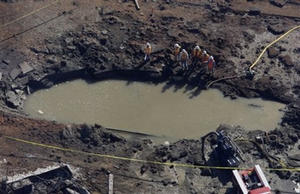InfrastructureReport finds poor management cause of San Bruno natural gas explosion
An investigation into the cause of a natural gas pipeline explosion that killed eight people and destroyed dozens of homes in San Bruno, California, placed the blame squarely on fifty-four years of bad management by Pacific Gas & Electric Company (PG&E) and the failure of state and federal regulators to notice the problem

Crater formed by the gas explosion at San Bruno, CA // Source: dantri.com.vn
An investigation into the cause of a natural gas pipeline explosion that killed eight people and destroyed dozens of homes in San Bruno, California, placed the blame squarely on fifty-four years of bad management by Pacific Gas & Electric Company (PG&E) and the failure of state and federal regulators to notice the problem.
“The city of San Bruno did not have this accident,” said Robert L. Sumwalt, the board member who proposed the title change. “The city of San Bruno and her residents were victims of this accident.”
The explosion occurred along a section of poorly installed pipelines dating back to 1956. When utility workers initially installed the pipe they skipped half the welds and years of inspections failed to find their errors, despite the fact that the missing welds should have been obvious in a visual inspection, said the report.
In addition the board found that the utility company failed to maintain proper records, assess risk, or understand its own computerized control centers.
Following the rupture, fiery jets erupted from the pipeline for nearly an hour because poor planning and organization impeded the company’s response. The board also found that PG&E had been months late in supplying information about a previous leak from the same pipe in the months preceding the explosion.
In response to the report, Brian Swanson, a spokesman for PG&E, said the company was focusing on implementing the board’s recommendations. “We’ve acknowledged our past operations and our past record-keeping procedures were not what they should have been,”he said.
After visiting the site of the accident, Deborah A. P. Hersman, the chairwoman of the National Transportation Safety board, said it was “baffling” that a utility company in an earthquake-prone area could have such a slow response to a pipeline rupture.
The board found that the company’s response was so slow that many of the critical work to close the valves were completed by off-duty mechanics who “self-dispatched.”
The board also blamed the California Public Utilities Commission for its inappropriate trust in the utility company and the U.S. Department of Transportation for failing to oversee the state agency.
